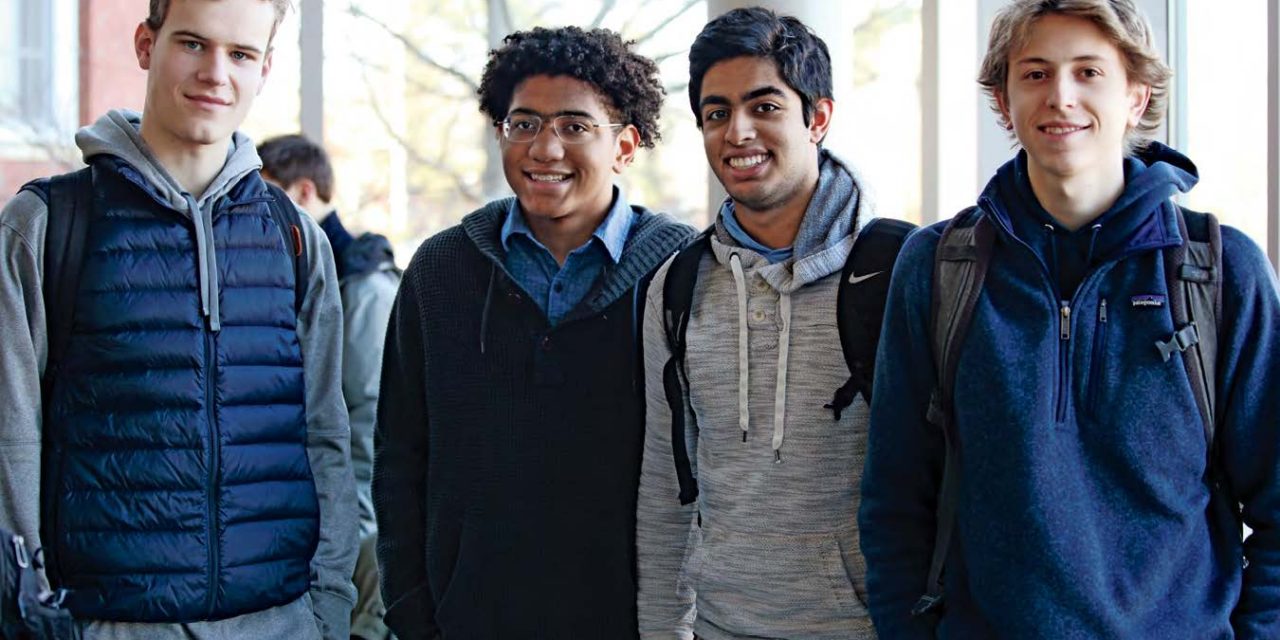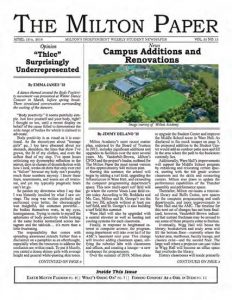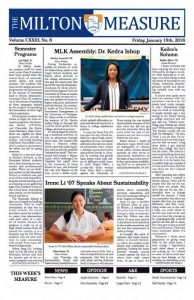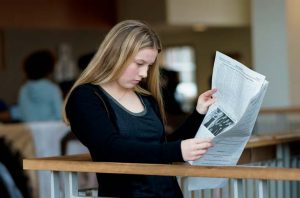
Trending Now: Life as student editors in chief, 2019

We know you’re curious. As media shift formats, position themselves on different platforms, eke out different style (and audience) niches, what is the status of the Milton Measure and the Milton Paper?
Working on the student newspapers at Milton generates abiding memories. Milton reporters and editors have chosen all kinds of careers over the years, but few—especially among the editors—forget the days when, under the pressure of tight deadlines, they kept other students and faculty informed, provoked and entertained.
Many aspects of life in the Fourth Estate are familiar and highly resonant. Digitization of our world, however, changes some of the fundamentals involved in discerning and publishing “the news.”
We have rendered the highlights from a revealing conversation with this year’s editors in chief:
John Albright ’19 and Andrew D’Ambrosio ’19, editors in chief, the Milton Measure
Rishi Dhir ’19 and Pierce Wilson ’19, editors in chief, the Milton Paper
A “kind of organic” next step if you love to write
All four editors do love to write. John loves politics and started in Class IV writing “politically charged articles” for the opinion section, before he “began the whole journey, becoming section editor, opinion editor, then applying for editor in chief.” Andrew came from the sports writing genre. He loved going to games, interviewing classmates about their games, and writing articles weekly. He learned how sensitive and challenging writing about athletes and competition can be. Rishi had written what he calls “straightforward, factual stories” for two years, but a summer writing program at the New England Center for Investigative Reporting powered up his interest and his skills. He learned “how to investigate and how to interview,” Rishi says, “skills that apply to my history papers and so many aspects of my writing here.” Pierce, who came to Milton as a robotics and science Olympiad team member, got a D- on his first Milton English paper. “I was committed to trying harder at writing, and then I really got into writing and English,” he says. He credits his English course, Perspectives, and his teacher, Ms. Dukuly, who relentlessly expected him to reach for the inherent complexity of things. “Any story, any person, can be more complicated if you’re willing to put in the time to look for the nuance,” Pierce says.
Writing apart from something for class is rewarding. The “generic analytical essay” is important, John explains, “but there’s an appeal to being able to write in a different format about something you actually care about and know about.”
It’s a way to learn a lot more. Writing an opinion article, for instance, involves digging into a subject. “I wanted to write about the Electoral College,” John remembers, “and that forced me to research a ton. I learned, and now I can speak about it. It was definitely a rewarding experience.”
 Content that is broad and balanced, if possible
Content that is broad and balanced, if possible
Ideally, the editors say, their papers strive for a balance: national, state and local, and Milton news. Reporting about Milton sometimes requires a certain creativity, however, because breaking news happens, but not consistently. Pierce’s example of a great instance of creativity is when the Paper writer Sarah Palmer ’20 interviewed 10 math teachers and then reported about their teaching styles and strategies. He also points to the Paper’s new “spotlight team,” led by its news managers, who are trying to do long-term investigative reporting over a month and then publish their work.
All the editors try hard to seek out different student and faculty voices, in stories and for quotations. Sharing opinions, through comments and especially through writing, requires a risk assessment if you’re in high school. That’s especially true if your opinion is outside the Milton mainstream, or you’re simply not confident about submitting your own writing.
The editors find that humor and opinion take the most work. Rishi says, “You are factoring in having to write things that are actually funny and relevant to Milton but don’t upset anyone—at that point you have a very, very small box in which you can operate. That’s not saying you can’t generate funny things. You can. But it’s a difficult balance to maintain.” Work with student humor writers is always challenging and time-consuming, the editors agree. The combined Measure/Paper annual humor issue the Shallot is always an exercise in learning the difference between what student and adult readers think is funny and what they don’t.
Given a green light to express their opinions in their columns, Milton writers will do just that. The editors’ task is to help their writers generate ideas for opinions that are outside favorite student themes such as gender, race, what “Dare to be true” really means, and student workload, and to help them see and research the complicated truth just under the surface of an idea. Pierce notes that they ask Milton Paper opinion editors to meet with the opinion writers once a month, to discuss ideas and how to write a piece that offers a different perspective if the issue has been written about before. They have an official guide to opinion—“like a style book,” he says, “that was created about 10 years ago.”
 The job’s challenges are predictable and call for new skills
The job’s challenges are predictable and call for new skills
“Getting and keeping people motivated and bought-in to what we’re trying to do,” says Andrew, “when they’re technically volunteers and newer writers who might have lower positions” demands attention and creative strategies.
“We need to help people feel like they’re part of something,” Pierce says. He recalls the power of an “incredibly nice” email of encouragement he got from Paper editors when, as a new writer, he completed a difficult article that provoked reaction on campus. “It’s such a transformative moment to get acknowledged by a senior,” he says. The Paper now sends “shout-outs” to highlight great work by their staff—not quite weekly, but enough to maintain the practice.
“We’re trying to make it feel like a club where everyone feels involved,” says Pierce. “We now offer office hours where writers can stop by, ask questions, and get feedback on their articles.” He doesn’t want people to feel that they send an article off to some “mystical place,” and a week later, it comes out with something changed, a different title, and their name on it.
All the editors feel community pressure: “If the article provokes controversy or there’s a mistake, it reflects on the board,” Andrew says. Ultimately, they agree, their readers are tough critics.
Students on the two editorial boards work intensely together—hours and hours over weeks and months. They have different styles and points of view. Learning how to disagree, how to value your teammates, how to keep your eye on the target, is crucial when you spend so much time together.
 From the assignment to the printed page
From the assignment to the printed page
As Andrew notes, “Journalism is a completely different form of writing than the academic writing that is students’ day-to-day experience.” Helping their writers to base their articles on facts and to be precise is a core task, and the two papers use various techniques. John says, “When we send out article assignments we tell writers to vary the sources of their information and to include quotes from students.” Andrew says that their routine process involves sending feedback along the way.
Pierce says his board is trying to give more comprehensive feedback. “On every round we like to give three rounds of editing. We start with box one, which is structural edits: Does it make sense? Is it factually accurate? Does it flow? Box two is grammar and mechanics, syntax, sentence style and variety. The third round is copy edits. We’re asking editors to leave comments at the bottom of each article after every round, and then the section editor who’s responsible for that writer sends them a typed-up paragraph of all the feedback they got that week. That’s less work for us in the long run, and less work for next year’s board, because they’ll have writers who’ve had feedback. Also, there’s more constant communication.”
Pierce is proud of a time when an article from a student was “factually incorrect, structure was awful, and historically inaccurate.” Two of his editors worked with the student over three weeks (it wasn’t time-sensitive), and the article was ultimately printed.
Paying the bills
A big difference between the two competing papers is money. As the “official” student newspaper, the Milton Measure has a budget provided by the School, which covers printing and other miscellaneous costs. Its faculty advisor pays the bills. But the Milton Paper is on its own when it comes to resources. The lack of funds gives the Paper some cred as an “independent” publication, but Pierce and Rishi must constantly think about how they are going to pay to print it. “Because we are always broke, we feel we have more liberty, in a way, and there’s some self-righteousness in students who are on the Paper, for better or for worse,” says Pierce. Fundraising is an important role for Paper editors, with Parents’ Weekend and Graduation the two biggest times of the year for raising money. They also have alumni and parent print and digital subscribers (www.themiltonpaper.com). The Milton Measure is able to offer its website without charge (www.themiltonmeasure.org) and send out free electronic copies upon request.
Today’s ways to stay current: the papers play a role
Most adults struggle to stay abreast, to know what’s important—from politics and economics through science, arts and humor, the best teams, the latest films, the most outrageous posts on social media. Students carrying a Milton course load, playing a sport or performing, applying to college, tending to friends and family and grabbing a little sleep, also feel like they’re trying to catch up with the flow.
Digitization, they all feel, helps with this problem. The upside of the firehouse of “notifications” and headlines from media, Twitter commentary, Snapchat messages and Instagram posts that inundate them is that they catch the drift without being weighed down in text and can then go for depth when and if they choose. But it’s also valuable that there are still two student print newspapers, hand distributed by student news staff on Fridays, in the student center, during the rush at recess. Many students immediately flip to the back covers to read the humor page or flip open the first page to read the editorials. Later, after the papers are stuffed into backpacks or strewn across Harkness tables, students can take the time to read through what their peers think about current issues, or how the girls’ basketball team’s season is going, or what movie is worth seeing. At Milton, print is not dead; it’s still a vibrant part of student life.
by Cathleen Everett and Liz Matson
The beginnings . . .
Originally published under the name the Milton Orange and Blue, the first issue of what today is the Milton Measure, appeared on Friday, November 16, 1894. “The object of this paper, besides being a source of information to those interested in the Academy, is to bind together former scholars by keeping them informed as to what is going on at Milton,” the new editors wrote. Those early years focused heavily on athletics with extensive game recaps. By the 1940s, the Orange and Blue was a full-fledged newspaper covering students serving in WWII, curriculum changes, “record enrollment,” the School’s 150th anniversary, and the ascension of Mr. Arthur Perry to the headmaster’s role. Sometime in the 1970s, there was a shift, and for a few years, students from the Boys School and the Girls School published the Milton Bi-Weekly under the leadership of Phil Tegeler ’73 and Vicky Boughton ’73. The Bi-Weekly faded away, and then the first issue of the Milton Measure was published, with Robert Potter ’78 as editor. Headlines read “Milton’s on Construction Binge” and “Dare to be True?”
The very first issue of the Milton Paper appeared one year later on October 15, 1979, with front-page stories covering new disciplinary procedures and the trustees’ announcement of a new campaign to double endowment. The editors were David Roth ’81, Ryck Birch ’81 and Jones Walsh ’82. “We’ve started this paper because we feel there should be an uncensored student forum at Milton Academy.” However, the Paper went into a hiatus after that inaugural year until a “rebirth” on September 16, 1983, under the leadership of Mark Denneen ’84, who wrote “While comparisons to the Measure are inevitable, we hope to augment, not replace, the Measure.”




